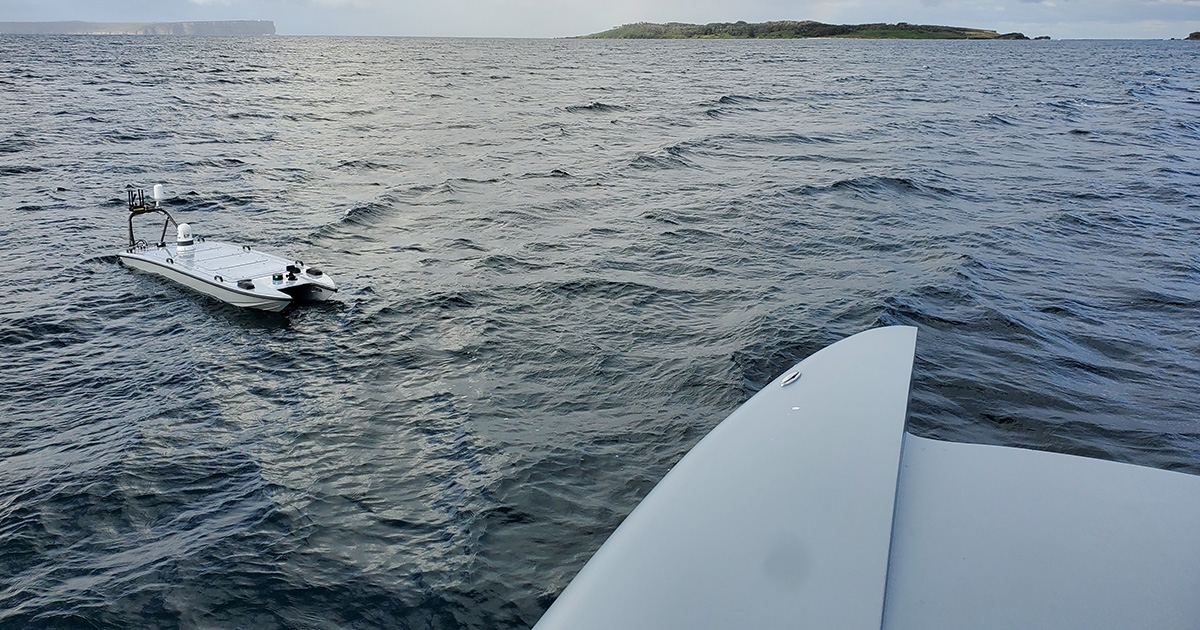The US Navy’s Designs on a Hybrid Fleet

The US Navy stands at the precipice of a new era of technology advancement. In an address at a major military-industry conference, the US Chief of Naval Operations, Admiral Michael Gilday, revealed the Navy’s goal to grow its fleet to 500 ships, comprising 350 crewed vessels and 150 uncrewed maritime vehicles. This plan has been dubbed the “hybrid fleet.”
The reason for this commitment to uncrewed maritime vehicles is clear. During the 1980s, the US Navy significantly expanded its fleet, reaching 594 ships in 1987. That number has declined steadily over time, to less than half of what it was at its peak. However, advances of uncrewed surface vehicle technology have provided the Navy with a new way to put more hulls in the water.
UNCREWED EXPANSION PLANS
Juxtaposed against this aspiration is the fact that the US Congress has been reluctant to authorize the Navy’s planned multi-billion-dollar-investment in USVs without a robust concept of operations (CONOPS) for using them. Congress has a point. The Navy has announced plans to procure large numbers of uncrewed systems—especially large and medium USVs—but an official CONOPS is yet to emerge. Additionally, while the composition of the future Navy’s crewed vessels is relatively well understood, what those uncrewed assets will look like, let alone what they will do, has yet to be fully determined.
That said, the Navy has taken several actions to define what the newly incorporated uncrewed maritime vessels will do, including the publishing of an UNCREWED Campaign Framework, standing up an Uncrewed Task Force; establishing Surface Development Squadron One in San Diego and Uncrewed Surface Vessel Division One in Port Hueneme, CA; and conducting a large number of exercises, experiments and demonstrations where operators have had the opportunity to evaluate uncrewed maritime vessels.
TACKLING LOGISTICS
All these initiatives will help inform a convincing CONOPS, which will need to include comprehensive logistics plans explaining how assets will get to a target operating area (for example, the Western Pacific), as well as details of the missions that they will perform once deployed.
The answer to the first question is that the Navy has committed to obtaining seven large uncrewed surface vehicles (LUSVs)—between 200–300 feet in length and with a displacement of 1,000–2,000 tons over the next five years.
An emerging concept of operations is to marry various size uncrewed surface, subsurface, and aerial uncrewed vehicles to perform missions that the US Navy has—and will continue to have—as the Navy-After-Next evolves. Simply put, the Navy can use the LUSVs as transportation for smaller USVs, UUVs, and UAVs into the battle space to perform critical missions such as intelligence, surveillance, and reconnaissance (ISR) and mine-countermeasures (MCM).
While there are a wide range of medium uncrewed surface vehicles (MUSVs) that can potentially meet the US Navy’s needs, there are three USVs that are furthest along in the development cycle. All are currently in production and fully operational. They are:
- The Vigor Industrial Sea Hunter is the largest of the three, launched in 2016 and built at a cost of $20 million.
- The Textron monohull Common Uncrewed Surface Vessel (CUSV), now referred to as the MCM-USV, which features a modular, open architecture design.
- The Maritime Tactical Systems Inc. (MARTAC), catamaran hull, USV line, which includes the MANTAS T12 and the Devil Ray T24, and T38 craft.
While all three of these MUSVs are viable options for an integrated uncrewed vessel CONOPS, the MANTAS T12 and Devil Ray USVs, which although different sizes share the same hull, mechanical, and electrical (HME) attributes, present practical advantages. The Sea Hunter is simply too large to fit into the LUSVs the Navy is considering and the CUSV is the MUSV of choice for the Littoral Combat Ship (LCS) Mine-Countermeasures Mission Package, and so all scheduled CUSVs are committed to this program.
Depending on the size that is ultimately procured, the LUSV could carry multiple T38 Devil Ray USVs and deliver them to a target deployment point. From there, the T38 can independently execute the ISR mission, or alternatively, would be able to launch one or more T12 MANTAS USVs to carry out required tasks. Building on work conducted by the Navy laboratory community and sponsored by the Office of Naval Research, the T38 or T12 will have the ability to launch UAVs to conduct overhead ISR campaigns.
For MCM exercises, the LUSV can deliver several T38s equipped with mine-hunting and mine-clearing systems. These vessels can then undertake the “dull, dirty, and dangerous” work previously conducted by humans. Given the large mine inventory of peer and near-peer adversaries, this uncrewed approach may well be the only way to clear mines safely.
INTEGRATING INDUSTRY
While the full details of how this CONOPS plays out is beyond the scope of this article, if the US Navy wants to keep its multi-billion-dollar capital ships out of harm’s way, it will need to integrate USVs into the battlefield while its manned ships stay out of range of adversary A2/AD systems, sensors, and weapons.
To be clear, this is not a platform-specific solution, but rather a concept. When fleet operators see a capability with different size uncrewed COTS (commercial-off-the-shelf) systems in the water working together and successfully performing the missions presented in this article, they will likely press industry to produce even more-capable platforms.
While evolutionary in nature, this disruptive capability, delivered using emerging technologies, will provide the US Navy with near-term solutions to vexing operational challenges, while demonstrating to a skeptical Congress that the Navy does have a concept-of-operations to employ the uncrewed vehicles it aims to procure.
This story was originally published in ON&T Magazine's August 2023 issue. Click here to read more.

